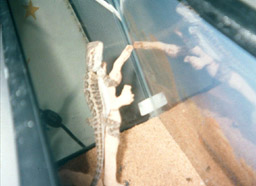|
|
|
 |
Bearded Dragon Information Page |  |
| Origins And Beardie Tank Set Up Bearded Dragons (Pogona Vitticeps), live in the deserts of Central Australia. The climate is arid, with scarce shrubbery, rocks, the dry heat making temperatures climb into the 100's. The are active during the day, natives of Australia finding them basking away on fence posts and rocks. When the sun sets, they retreat to a hiding spot where the sleep. Beardies are ectotherms, which means they obtain heat from their surroundings, the same as snakes. They must thermoregulate (moving to and from a heat source to adjust their body temperatures). A hatching or juvenile will do good in a 10 or 15 gallon tank. As adults, the bigger the better. They seem to enjoy the extra room with plenty of branches and rocks to climb and bask on. The tank should have a good, safe substrate. For hatchlings though, paper towels are best to start with. There is always debate on what is the best substrate. Washed play sand seems to rank #1 with beardie owners. I use Repti-Sand from ZooMed, and have used crushed walnut shell and Calci-sand. Shop around, ask your vet, and find what you think is best. You can add fake plants also. Heat and lighting is VERY important for your beardies health. They need UVB lighting for their bodies to properly manufacture Vitamin D. This helps their bodies to use calcium efficiently. The also need a good heat source. Get a daylight heat bulb and put it on one side of the tank. Get a thermometer to monitor the temperatures. They need a high heat of 100-105 for proper digestion. The cooler end of the tank should be about 85 during the day. At night, the temps can drop into the 30's (So I have read) but I keep mine in the higher 60's. I have a heat pad underneath the basking site, just for extra heat to their bellies when they sleep. And BOY do they sleep!! They are deep sleepers!! Check my Links page for other sites on this! They need to have a good combination of day/night. About 14 hours of daylight in the spring/summer and about 10 hours of daylight in the winter months. I have timers on my tanks, so it is easy to set them and they automatically shut on and off. Comes in handy if you work late, sleep in, etc. |
 |
|
A Good Diet Is A Must..... Vegetables should also be offered every day, twice a day. Dark, leafy greens are best. Iceburg lettuce is a big NO-NO!! It offers no nutrients and will sometimes give the beardies the "runs'!! Some good veggies to offer are Collard greens, mustard greens, dandelion greens, carrot tops, zucchini, bell peppers, yellow squash, carrots, green beans, peas, and cooked corn. Every once in awhile I will add some fruit as a treat for them. The LOVE bananas, but they contain phosphorous, which blocks calcium absorbtion. Apples, strawberries, melons, grapes and pears can be offered. Spinach also has phosphorous so use in small quantities, occasionally!! Beardies usually won't drink standing water, but I have a bowl of water in their tanks. I mist my beardies every other day with lukewarm water. They will lick it off their face. If you have plants in the tank, you can mist those too. In the wild, they will lick the water and dew off of plant leaves. Since beardies come from the desert areas, they conserve water in their bodies very well!! Shedding..And Yes, Beardies Can Get Sick Too... More On Brumation and Breeding Soon!! |
|